
Benefits of Airplane Ceramic Coating for Aircraft Protection
Share
Airplane ceramic coating is your answer to enduring protection and improved aesthetics for aircraft. This insight-packed article will take you through how these coatings safeguard against harsh elements and keep your plane shining. Expect a deep dive into the essential science, practical application advice, and tips for upkeeping that polished look.
Key Takeaways
-
Ceramic coatings protect aircraft from environmental damage such as UV rays, moisture, and pollutants, and also enhance the aircraft’s appearance with a glossy, hydrophobic finish.
-
Professional application of ceramic coatings is more durable, lasting up to 5 years, while DIY kits are more cost-effective but may require annual reapplication.
-
Proper surface preparation is crucial for effective ceramic coating bonding, and high-quality brands like System X, CeramicPro, and Mach Coatings are recommended for different application requirements.
The Ultimate Aircraft Protection: Ceramic Coating
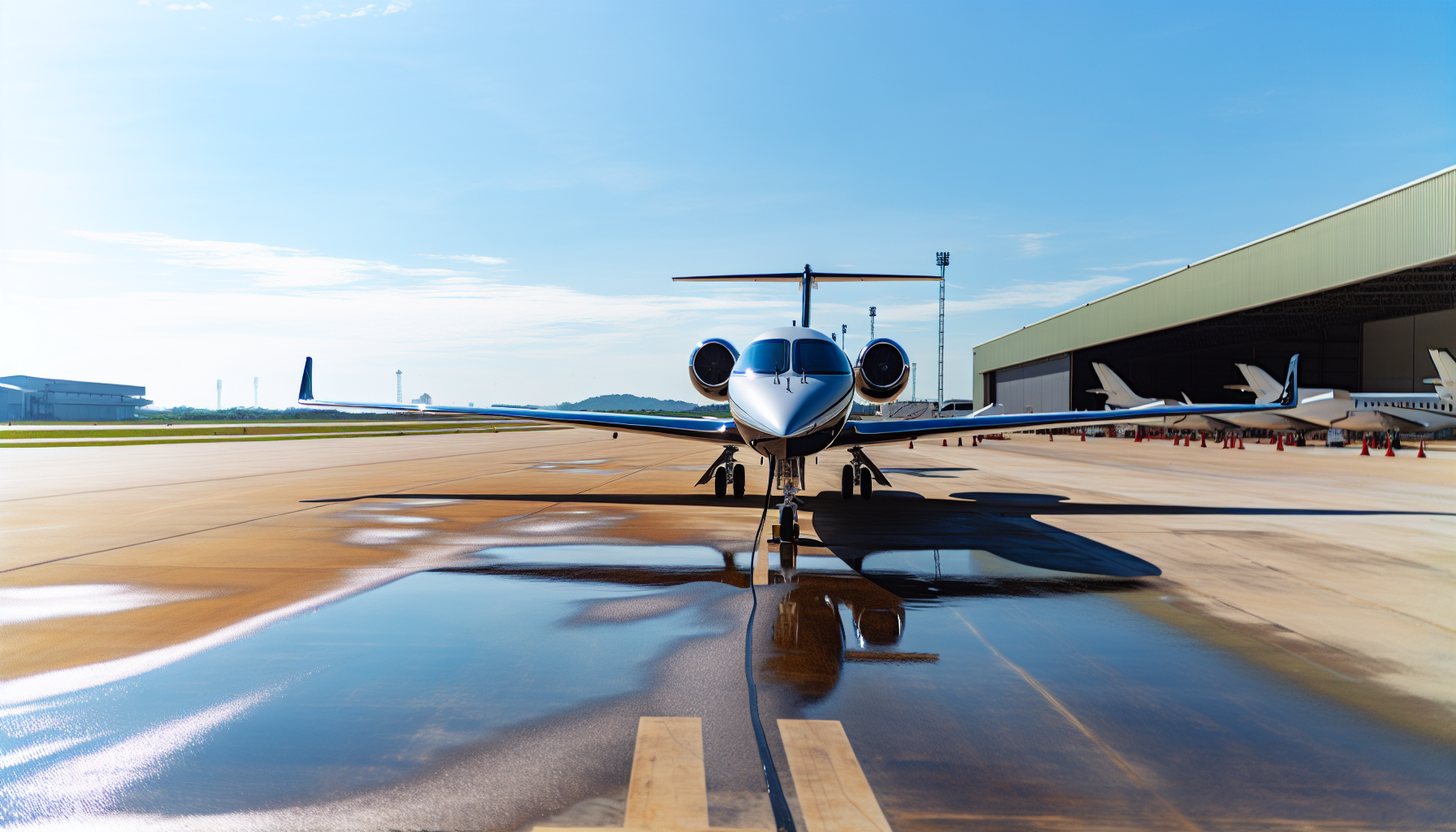
Ceramic coatings offer an unmatched level of protection for your aircraft’s surface. These innovative layers are specifically engineered to shield the paintwork of your aircraft from a wide array of environmental hazards, such as:
-
The harmful effects of UV rays
-
Excess moisture buildup
-
Extreme fluctuations in temperature
-
Pollutants like acid rain and exhaust fumes
-
Oil spillovers
They defend against degradation caused by deicing chemicals as well as biological contaminants left by birds or insects.
By laying down a ceramic coat on your aircraft, you’re essentially providing it with unparalleled protection that also helps ward off minor scratches and various other forms of surface wear that can occur through regular use. Prioritizing surface preparation using a clay bar before applying the ceramic coating will ensure optimal smoothness for superior adhesion and effectiveness.
The advantages offered by ceramic coatings go beyond mere protection. They also enhance the aesthetic appeal of your aircraft. Some key benefits include:
-
Maintenance becomes easier due to their oil-repelling capabilities which keep areas prone to oil breather residue and exhaust soot cleaner.
-
Their hydrophobic properties result in finishes that effectively repel water along with oils and dirt, ensuring the cleanliness and pristine look is preserved longer.
Lastly, these advanced coatings act as a clear layer over the paintwork which not only delivers substantial shielding but also enhances color vibrancy giving long-lasting luster while defending against abrasions.
The Science Behind Ceramic Coatings
By forming a strong bond with an aircraft’s surface, ceramic coatings leverage nanoceramic particles that chemically attach to the surface using silicon dioxide (SiO2), extracted from quartz crystals and sand. The protective capabilities and endurance of the coating hinge on its SiO2 content.
Distinguished for their suitability in aviation and proven durability, premium ceramic coatings such as Element 119’s System X excel compared to alternative coating systems. They provide exceptional resistance alongside numerous advantages.
-
Establishing a hard, glossy semi-permanent bond capable of enduring environmental stressors, including heat
-
Effectively repelling water, oils, and dirt
-
Delivering UV protection
-
Enhancing the overall lifespan of the coating
Achieving these results requires that an aircraft’s functional surface is free from chemicals to ensure thorough bonding. This may necessitate cutting-edge methods like Smart Surface Technology which delve into minute pores or eradicate scratches and swirl marks for optimal preparation.
Application Methods
Applying a ceramic coating to an aircraft’s surface demands meticulous preparation. This process involves:
-
Rigorously cleaning the surface with warm water and a cleanser that does not contain wax or silicone.
-
Employing a decontamination solution.
-
Rectifying any flaws by compounding.
Executing these steps guarantees that the ceramic coatings will adhere effectively, yielding superior results.
Professionals and DIY enthusiasts alike can administer ceramic coatings. When professionals do it, the results tend to last much longer—up to five years—as opposed to consumer-grade options designed for simpler at-home application. The best conditions for applying ceramic coatings include ample lighting on days that are both warm and dry, usually within the shelter of a hangar where proper leveling and curing can take place.
Following its application, it is crucial for the coating to undergo at least 24 hours of cure time in an environment that is both cool and free from moisture so as to preserve its shiny appearance.
Enhancing Your Aircraft's Appearance with Ceramic Coating
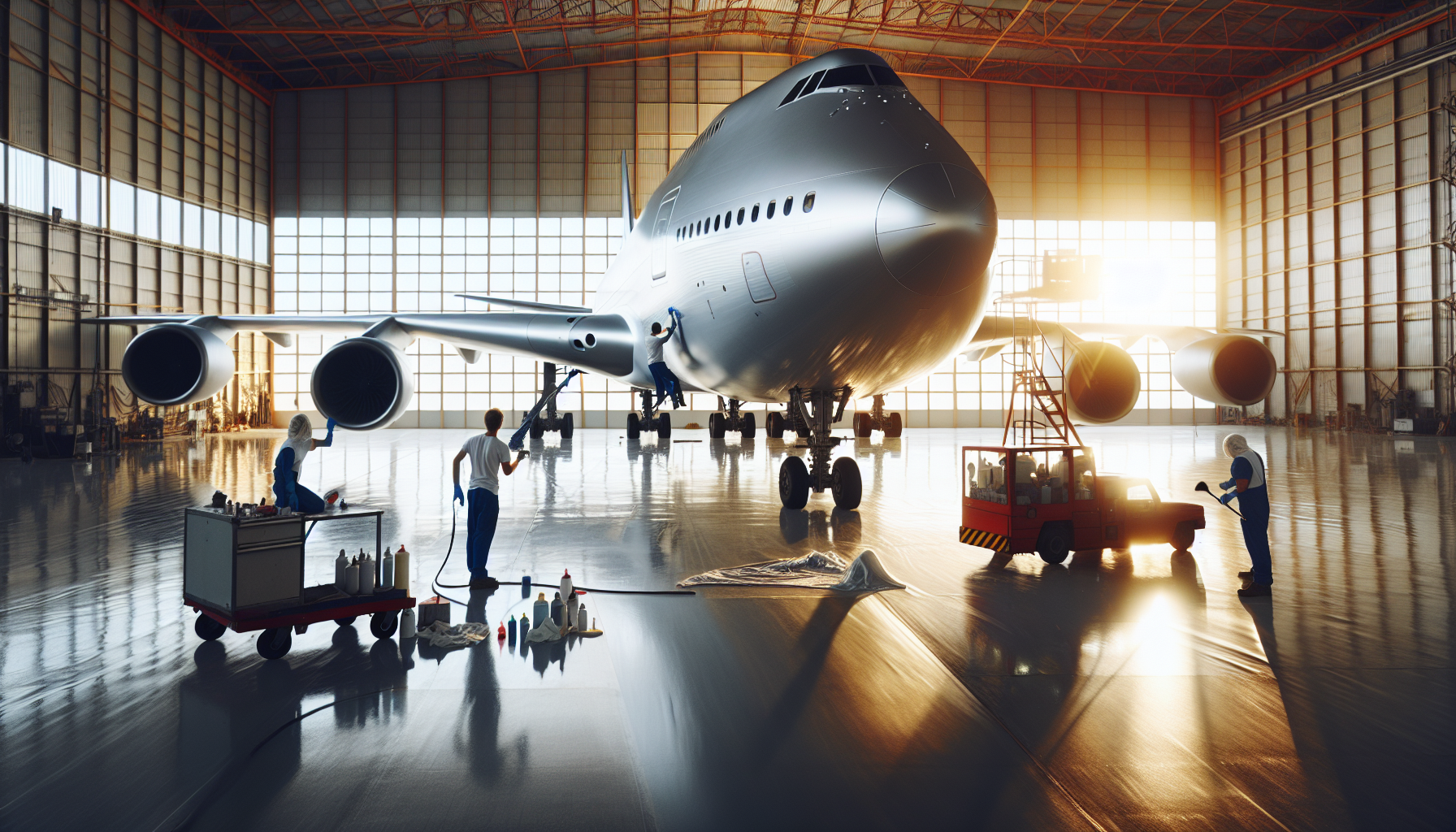
Ceramic coatings not only safeguard your aircraft, but also elevate its aesthetic appeal significantly. The coating imparts a glossy, candy-like finish to the paintwork of the plane, enhancing its visual allure. No matter if your aircraft is fresh from assembly or has seen many skies, applying a ceramic coat will intensify the shine and maintain the vibrancy of colors in your paint, thus heightening its overall appearance.
For older aircraft with diminished luster in their paint job over time, premium-quality ceramic coatings can revive that lost sheen and brightness. By adhering to and forming a bond with the surface of your aircraft’s exterior, these coatings reinforce either gloss or matte finishes by adding an ultra-smooth protective layer on top. This way they provide both beautification and defense for your craft’s painted surfaces.
Paint Correction and Deep Cleaning
Before a ceramic coating can be applied to an aircraft’s painted surfaces, it is essential to carry out meticulous preparation in order not to compromise the integrity of the final protected surface. This involves paint correction and deep cleaning steps such as:
-
Intensive cleansing and removing oil from the aircraft’s exterior.
-
Using compounds for smoothing and then polishing the paint.
-
Finalizing with a solution of IPA alcohol mixed with water to eliminate any remaining impurities.
This initial stage of treating the paint, while demanding in terms of effort, enhances the resilience of the ceramic coating and simplifies future applications by reducing their complexity. For maximum shine and protection offered by a ceramic coat, owners must assess their aircraft’s existing paint condition attentively and undertake appropriate maintenance measures for effective protection of their investment’s appearance.
Maintaining the Gloss
Ceramic coatings are recognized for maintaining a lustrous appearance, withstanding the effects of weather and repelling pollutants that could otherwise mar their shine. Thanks to the slick nature of these ceramic layers, keeping them clean and preserving their gloss becomes much less laborious. The coating’s outstanding resistance to numerous environmental challenges guarantees enduring protection.
Specifically taking Mach Coatings’ Aviation Ceramic Spray as an example.
-
It produces a water-repellent hydrophobic barrier.
-
Its low surface tension facilitates easy cleaning processes.
-
It effectively maintains the aircraft’s glossy exterior.
Mach Coatings' Aviation Ceramic Spray: A Game Changer in Aviation Care
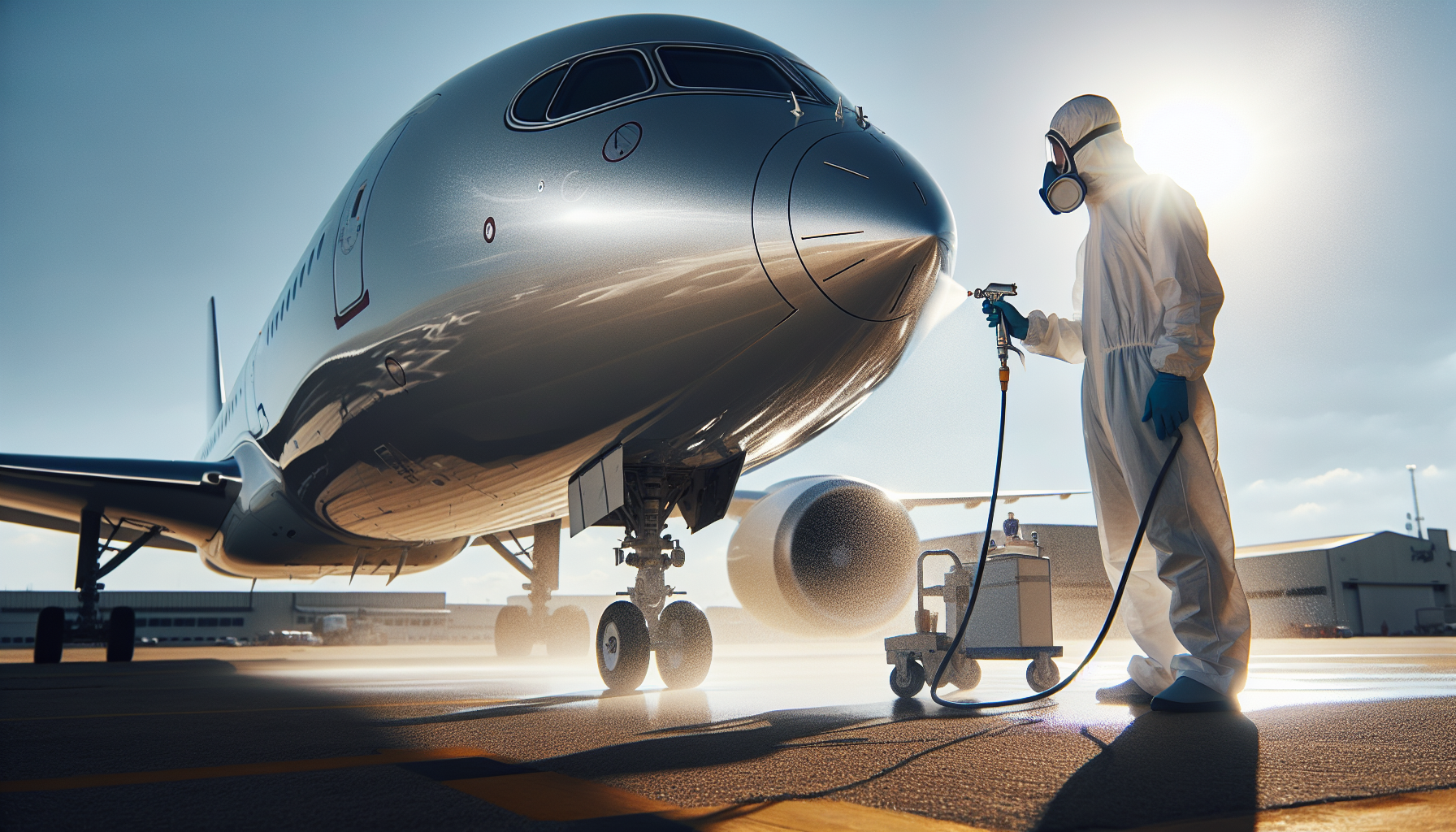
Aviation Ceramic Spray, developed by Mach Coatings, offers a cutting-edge substitute to conventional aircraft paint for aviation aficionados and private pilots. The spray lays down a durable, water-repellent coating that elevates the look of the aircraft with its lustrous sheen while being composed of environmentally friendly substances.
This breakthrough in aircraft coatings streamlines upkeep, cuts down on time spent cleaning, and assists in preserving the immaculate state of the aircraft.
Long-Lasting Hydrophobic Layer
The hydrophobic protective coating of the Aviation Ceramic Spray confers several benefits.
-
It establishes a repellent barrier against water.
-
The aircraft’s surface becomes less prone to contaminants adhering to it.
-
Preserves the shine and visual appeal of the aircraft.
Upon application, this ceramic spray delivers key advantages including:
-
Establishing a resistant hydrophobic layer that stands up against washing or chemical removal, offering long-lasting protection.
-
Easing upkeep efforts which leads to diminished time spent on cleaning.
-
Aiding in keeping the aircraft in an immaculate state.
Commitment to Innovation and Sustainability
Mach Coatings is dedicated to advancing innovation without compromising on the highest quality levels in aircraft maintenance. Their Aviation Ceramic Spray, for instance, has been crafted using environmentally friendly components, emphasizing their pledge not only to produce premium products but also to foster environmental well-being. This highlights Mach Coatings’ dual focus on excellence and sustainability within the realm of coatings and ceramics.
Real-Life Testimonials: Pilots Share Their Experiences with Ceramic Coatings
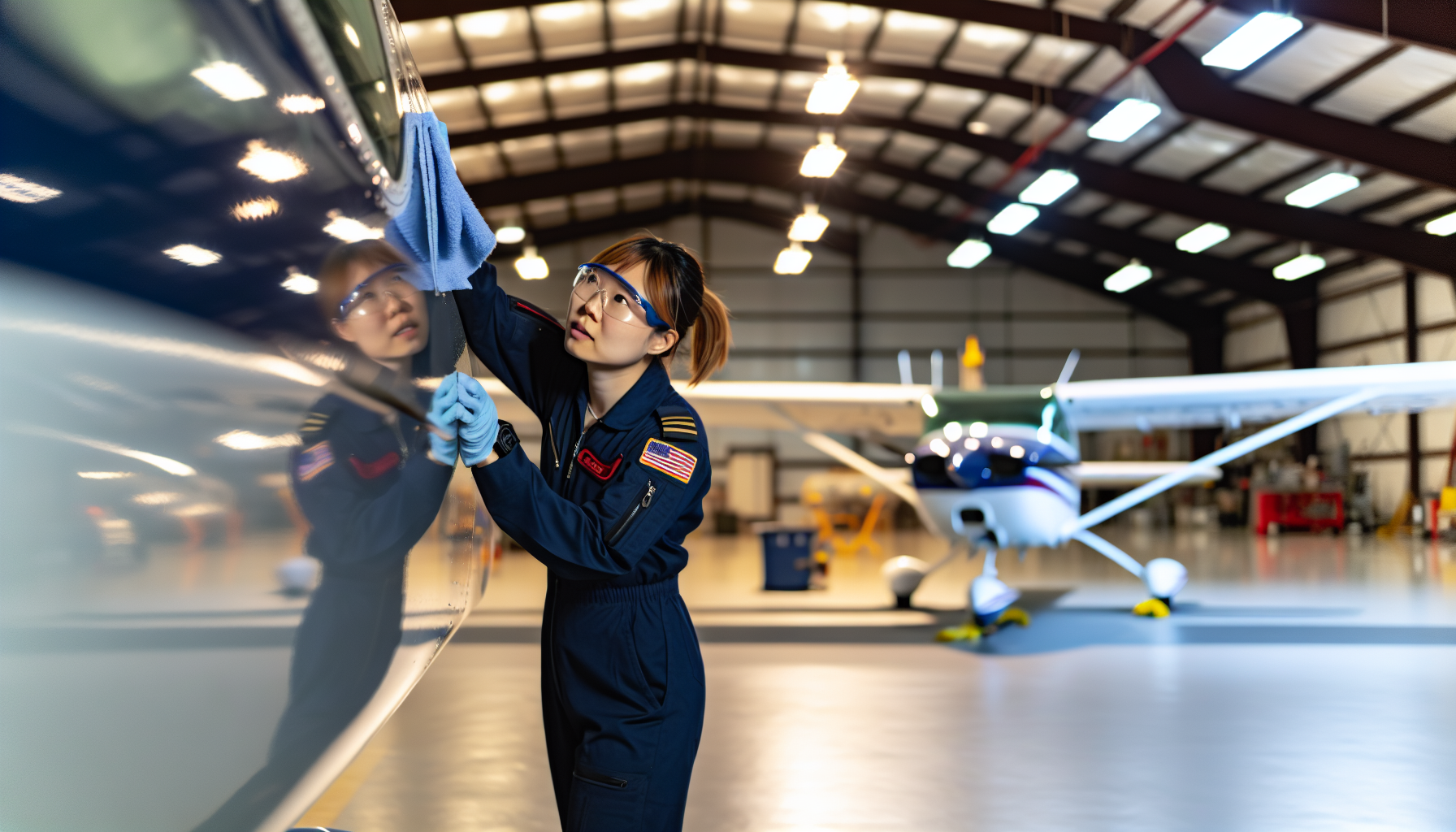
Aviators who have applied ceramic coatings to their aircraft report significant improvements in cleaning efficacy. Contaminants and insects can be swiftly eliminated, resulting in the craft’s paint exhibiting a remarkable luster that could easily be confused with a new coat of paint. Notably, the resilience of these ceramic layers means they often surpass the original paint’s gloss even after numerous years.
While professional applications of ceramic coating can command prices up to $3500, aviators inclined towards self-application might only incur expenses near $500. This represents an economical option that doesn’t greatly sacrifice performance quality.
Choosing the Right Ceramic Coating for Your Aircraft
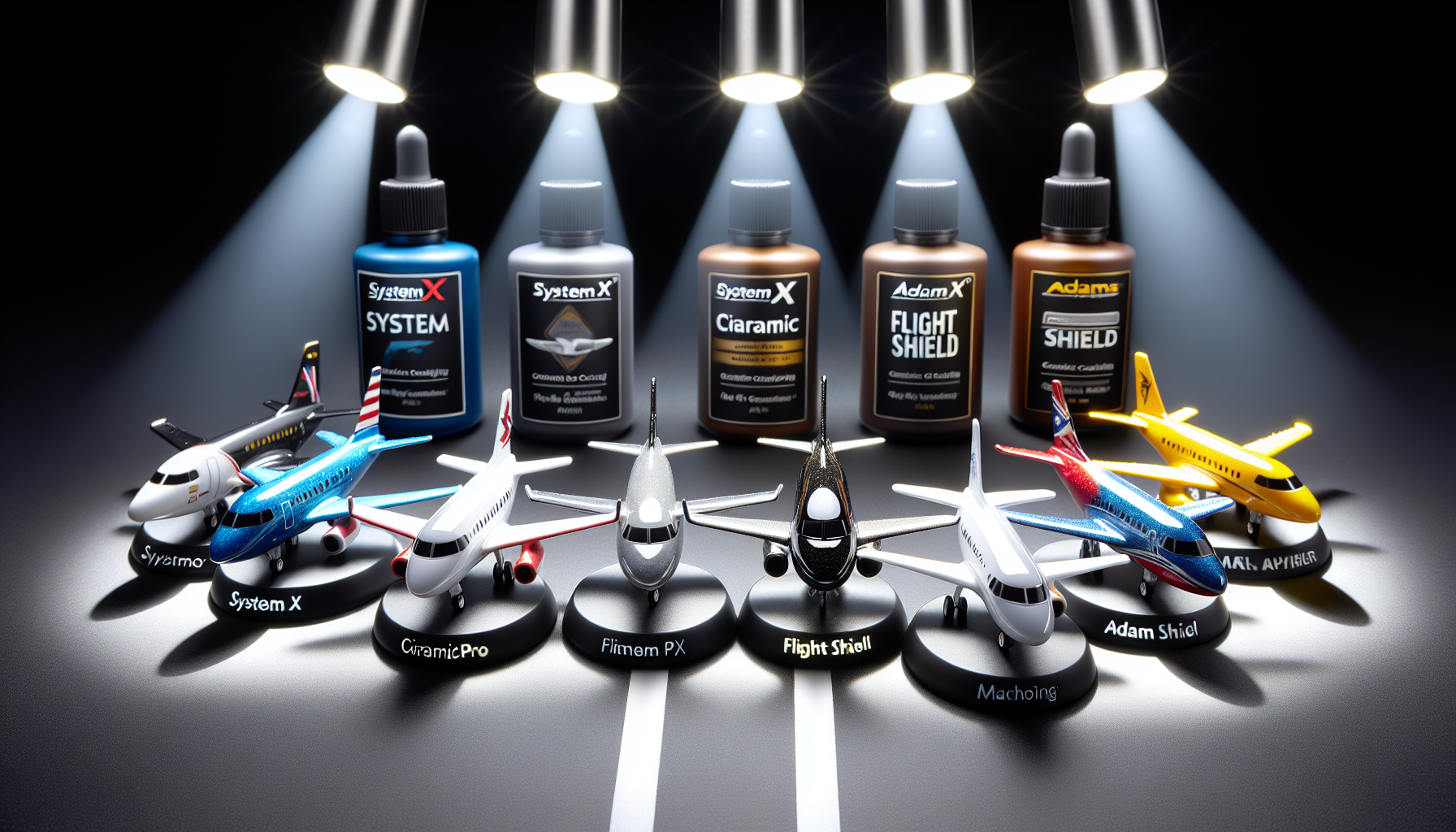
Selecting the correct quantity of ceramic coating for an aircraft depends on its dimensions, as this dictates how much coating is needed. Glidecoat’s ceramic coatings offer a useful guide by specifying that 50ml is enough to cover 60 square feet with two layers, which helps owners determine the necessary amount for their particular aircraft.
In contrast, Mach Coatings offers a solution wherein one bottle of 16 ounces can coat close to 250 square feet in just a single application. This makes it particularly suitable for smaller class airplanes where extensive coverage isn’t required.
Brands to Consider
In the market of ceramic coatings, there are several leading brands. Element 119’s System X and CeramicPro stand out for their professional-grade ceramic coatings tailored for diverse surfaces on aircraft. Flight Shield’s Sapphire V1 also holds a place in the market, specifically aiming at consumer use with its DIY-friendly application suited to an array of aircraft.
For those who own aircraft and have an interest in self-application of ceramic coatings:
-
Gtechniq Crystal Serum Ultra offers a high-end solution typically reserved for professionals.
-
Adam’s Polishes provides an alternative with their version suitable for aviation enthusiasts.
-
Mach Coatings presents an affordable aviation-specific ceramic kit that is compatible with any type of aircraft, retailing at less than $100.
DIY vs. Professional Application
When choosing between applying ceramic coatings oneself or engaging professional services, multiple considerations come into play. Professional-grade application of ceramic coating is guaranteed to be free from flaws and typically comes with a warranty covering the workmanship. Such expert applications on light single-engine aircraft can incur costs ranging from $1,500 to $3,000 due to the premium quality of materials and labor required.
Conversely, DIY attempts at applying ceramic coatings may lead to imperfections such as streaking and hazing. They also tend not to endure as long as those applied by professionals. The SiO2 content in consumer-level ceramics used for do-it-yourself projects is reduced, which simplifies the process but compromises durability compared with professional versions. Aircraft owners who go down the self-application route should prepare for yearly reapplication and might benefit from practicing on other vehicles first to hone their technique.
Summary
Ceramic coatings are a revolutionary development in aviation care. Providing incredible protection from environmental factors and minor abrasions, they not only safeguard your aircraft, but also enhance its visual appeal. The science behind these coatings involves bonding nanoceramic particles to the aircraft’s surface, which creates a hard, durable, and resistant finish. With the right preparation and application methods, you can maintain the gloss of your aircraft and keep it looking pristine. Brands like Mach Coatings’ Aviation Ceramic Spray are leading the way with products that offer a long-lasting, hydrophobic layer and a commitment to sustainability. Testimonials from pilots and the consideration of different brands and application methods give you the information needed to make an informed choice. Ultimately, ceramic coatings are an investment in your aircraft’s longevity and aesthetics.
Frequently Asked Questions
Can you ceramic coat an airplane?
Certainly, an airplane can be treated with a semi-permanent coating such as System X for ceramic protection. This type of ceramic coat not only imparts a lasting shine but also offers enduring defense to the aircraft’s surface.
What does it cost to ceramic coat an airplane?
The price for applying a ceramic coating to an airplane can vary based on aspects such as the aircraft’s size, age, and overall state. To illustrate, coating a single-engine turboprop could typically fall into the lower $3,000 range.
Can you fly with ceramic coating?
Flying with a ceramic coating is indeed secure, as it enhances safety and visibility in adverse weather conditions during flights, plus comes with a manufacturer’s warranty to protect against any defects.
What are the disadvantages of ceramic coating?
Applying a ceramic coating is both costly and requires considerable time investment, necessitating the skills of an expert for its correct application.
What protection do ceramic coatings offer for my aircraft?
Ceramic coatings provide a shield for aircraft against an array of environmental hazards including UV rays, moisture, severe temperature fluctuations, airborne pollutants, deicing chemicals, oil and exhaust emissions as well as residues from birds and insects. They also deliver defense from light scratches and marks.
Such coatings are instrumental in preserving both the aesthetic appeal and structural integrity of your aircraft.

